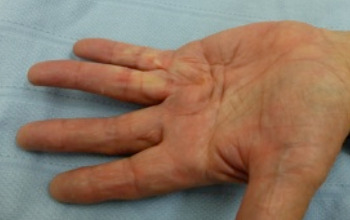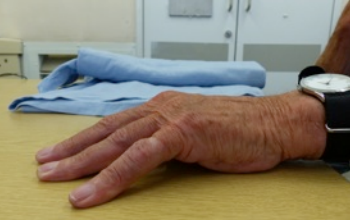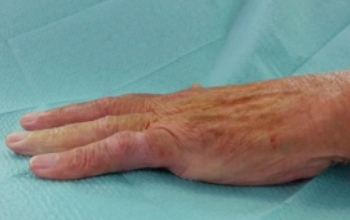Thickenings can appear in the palm of the hand and the fingers and these may become tight, causing fingers to bend.
This is Dupuytren's disease. It typically runs in families and may have originated amongst Viking populations. It occurs spontaneously although it can occasionally be triggered by a small injury or operation.
The contracted finger(s) make some functions difficult (putting hand into pocket, manipulating certain objects). The contracture never settles on its own and usually continues to worsen - sometimes quickly and sometimes slowly. Although it is not a dangerous condition, the longer it is left untreated, the more difficult it is to get a good result because the bones and ligaments of the finger joints start to be damaged.
If the hand cannot be placed flat on the table it is advisable to seek specialist treatment.
Depending upon the severity of the condition and the circumstances of individual patients there may be some choice about the options available for treatment:
Open surgery, which can be performed as a daycase awake procedure, is considered to be the 'gold standard' in terms of minimising the chances of recurrence because it removes most of the abnormal thickened tissues. It has the disadvantage of requiring dressing changes for 2-3 weeks after surgery and specialist hand therapy for 2-3 months.
Alternative treatments interrupt the tight tissue without removing it. This is done either by using a sharp needle to sever the tissue (needle fasciotomy) or by using a powerful enzyme (Xiapex) to dissolve small sections. These techniques allow fingers to be straightened but do not remove the tight dupuytens tissue. As a result there is a greater chance of recurrence and also a small chance that the bend in the finger will be barely corrected. In addition, they are not appropriate for more complex cases. Despite this, the convenience of these alternative treatments makes them an appealing choice for many patients.
"Mr. Harley was professional, informative, attentive and kind throughout the time I was in his care and I would unhesitatingly recommend him to anyone seeking treatment for Dupuytrens - and indeed any other hand condition." JC. West London
“You’ve done a marvellous job; stitching was so neat and wounds all healed up very quickly.” MK. Epsom.
“…..very pleased, I’ve got to say that afterwards there was hardly any pain.” EC. Epsom.
“Thank you so much - I really appreciate what you have done for me.” BT. Carshalton.
“…..very pleased - you have done a good job.” PM. Uckfield


The patient opted for a "needle fasciotomy". Under local anaesthetic, the tight tissue was released with a sharp needle. The procedure takes only a few minutes. It is immediately possible to move and use the hand after treatment. No bandaging is necessary, only a sticking plaster for a couple of days in most cases.


